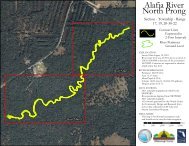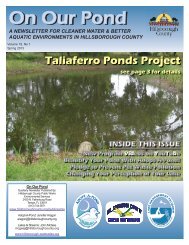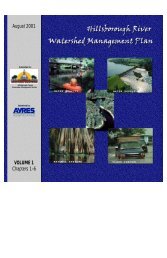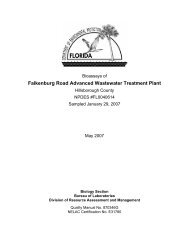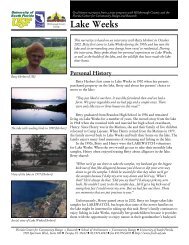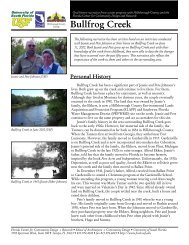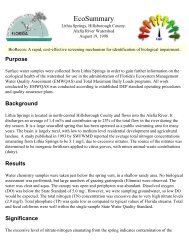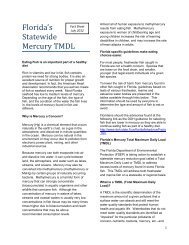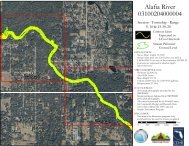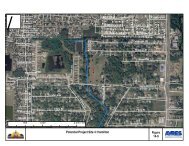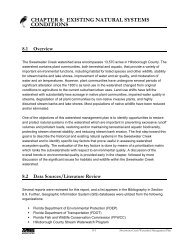Rocky Brushy Creek Watershed Mgmt. Plan (2007) -- Part 2
Rocky Brushy Creek Watershed Mgmt. Plan (2007) -- Part 2
Rocky Brushy Creek Watershed Mgmt. Plan (2007) -- Part 2
Create successful ePaper yourself
Turn your PDF publications into a flip-book with our unique Google optimized e-Paper software.
EXISTING NATURAL SYSTEMS CONDITIONS8.5 Natural Systems Issues and Areas of Concern8.5.1 Habitat Loss, Degradation, and FragmentationAs described above, the <strong>Rocky</strong>/<strong>Brushy</strong> <strong>Creek</strong>watershed was once composed of a variety ofupland and wetland habitats. Within the last century,many large tracts have been converted from naturalland features to agricultural uses, predominantly inthe northeastern and southern portions of thewatershed. Based on 2004 SWFWMD land usedata, approximately 64% of the watershed has beenaltered by human activities with approximately 8.7%of the watershed impacted by agricultural activitiesand approximately 46% developed for urban,suburban, commercial, industrial, and mining uses. Lands in a near-natural condition (uplands,wetlands) comprise an estimated 36% of the watershed, although most native habitats aredisturbed and degraded to some degree by agricultural practices, urban development, or waterproduction activities in the watershed.Despite these alterations and impacts to natural systems, some large tracts containing freshwaterwetlands, hardwood swamp, and saltwater marsh remain undeveloped in the watershed.Protection is provided by means of regulatory programs of SWFWMD and EPC and by theacquisition of 2,416 acres (6% of the watershed) critical to preservation and restoration.Habitat FragmentationHabitat fragmentation is defined as the break-up of a continuous landscape containing largepatches into smaller, numerous, less connected patches. To measure habitat fragmentation withinthe watershed, ArcView was used to join contiguous natural habitat polygons from SWFWMD’s2004 land use layer. The polygons with FLUCFCS code of 3000, 4000, 5000, 6000, and 7000(natural systems designations) were dissolved to form contiguous polygons throughout eachwatershed. The areas of these contiguous polygons were then calculated and compared to theoverall area of a given watershed. If one or more contiguous polygons represented a significantproportion of a watershed (i.e., greater than 75%), the watershed was categorized as havingrelatively little fragmentation. Alternately, if a watershed was comprised of several small contiguousnatural systems polygons and few large contiguous polygons, then the area was categorized asbeing highly fragmented. Large numbers of small polygons represent a high level of fragmentation,while small numbers of large polygons represent a low level of fragmentation (Table 8-5).8-20<strong>Rocky</strong>/<strong>Brushy</strong> <strong>Creek</strong> <strong>Watershed</strong> Management <strong>Plan</strong>



